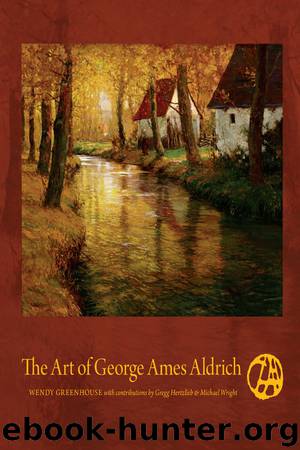The Art of George Ames Aldrich by Greenhouse Wendy Hertzlieb Gregg Wright Michael

Author:Greenhouse, Wendy, Hertzlieb, Gregg, Wright, Michael
Language: eng
Format: epub
ISBN: 9780253009135
Publisher: Indiana University Press
2.16. Calendar for 1938 issued by Caswell’s National Crest Coffee, featuring Aldrich’s painting Springtime. Collection of Peter Lundberg, Janus Galleries, Madison, Wisconsin.
Nowhere in America was more fast-moving than Chicago, but in 1926 Aldrich returned there at least part-time, while, as noted, retaining a close affiliation with South Bend. Perhaps his confidence in his competitiveness on the Chicago art scene was boosted by his winning the Thompson Prize in that year’s Chicago and Vicinity exhibition at the Art Institute. Even as traditionalists such as Aldrich found themselves increasingly sidelined in a museum that was rapidly acclimating itself to modernism, they encountered alternate venues for exposure and sales. The mid-1920s saw the births of the Chicago Galleries Association, a commercial cooperative, and the Hoosier Salon, held in the galleries of the Marshall Field and Company department store.67 Both offered direct access to “a large and many-minded public” of viewers not always comfortable with the modernist “isms” on display at the art museum or, for that matter, with the practice of owning original artworks; the CGA, for example, offered lay members the opportunity to borrow from a circulating collection of artist-members’ work in an effort “to place ‘art’ in the hands of the public – to put it literally in the home.”68 While Aldrich continued to show almost annually in the Art Institute’s Chicago and Vicinity exhibition through 1928, the CGA and especially the Hoosier Salon, which kept his work visible to the Indiana public, became important outlets from which he carried off several awards and distinctions. The last was a winter landscape prize at the Hoosier Salon in 1932, a fitting final recognition of his status as the “wizard” of snow and streams.
In the final decade of his career, Aldrich made the ultimate connection to would-be art consumers he described as “not in the plutocratic class” – through the medium of mass-market reproductions.69 In addition to the International Harvester and Caswell’s Coffee calendars featuring French stream-and-mill paintings, these included a suitable-for-framing print of one of his signature Midwestern winter stream images (Plate 28): it was distributed to promote a popular brand of toothpaste, undoubtedly in the hope that viewers would associate the purity of Aldrich’s snow with a brilliant smile. By then the hard-up artist, driven by alcoholism and depression to repeat stays in a state psychiatric hospital, could profit little from whatever windfall these reproductions brought. Yet such commercial applications of his work demonstrates the arrival of Aldrich’s high art formula as a mass-market commodity, one that fulfilled a “generally understood” if only vaguely articulated notion of art as reliably representational, soothing in its harmonious effects, affirmative if not inspiring, and offering a decorous livability that would stand up to daily encounter.
In Aldrich’s paintings, these qualities were most typically embodied in images that played to anti-modern anxiety in their romantic escapism, whether they presented such a quotidian subject as the modern factory or a European village-and-stream scene charged with wistful retrospection. Like Aldrich’s largely fictive professional persona as an internationally renowned
Download
This site does not store any files on its server. We only index and link to content provided by other sites. Please contact the content providers to delete copyright contents if any and email us, we'll remove relevant links or contents immediately.
Aircraft Design of WWII: A Sketchbook by Lockheed Aircraft Corporation(32140)
The Great Music City by Andrea Baker(30797)
Call Me by Your Name by André Aciman(19928)
The Art of Boudoir Photography: How to Create Stunning Photographs of Women by Christa Meola(18414)
The Secret History by Donna Tartt(18217)
Shoot Sexy by Ryan Armbrust(17563)
Plagued by Fire by Paul Hendrickson(17119)
Portrait Mastery in Black & White: Learn the Signature Style of a Legendary Photographer by Tim Kelly(16877)
Adobe Camera Raw For Digital Photographers Only by Rob Sheppard(16805)
Photographically Speaking: A Deeper Look at Creating Stronger Images (Eva Spring's Library) by David duChemin(16504)
Ready Player One by Cline Ernest(14030)
Pimp by Iceberg Slim(13801)
Bombshells: Glamour Girls of a Lifetime by Sullivan Steve(13700)
The Goal (Off-Campus #4) by Elle Kennedy(13208)
Art Nude Photography Explained: How to Photograph and Understand Great Art Nude Images by Simon Walden(12858)
Kathy Andrews Collection by Kathy Andrews(11341)
The Priory of the Orange Tree by Samantha Shannon(8633)
Thirteen Reasons Why by Jay Asher(8468)
The remains of the day by Kazuo Ishiguro(8412)
